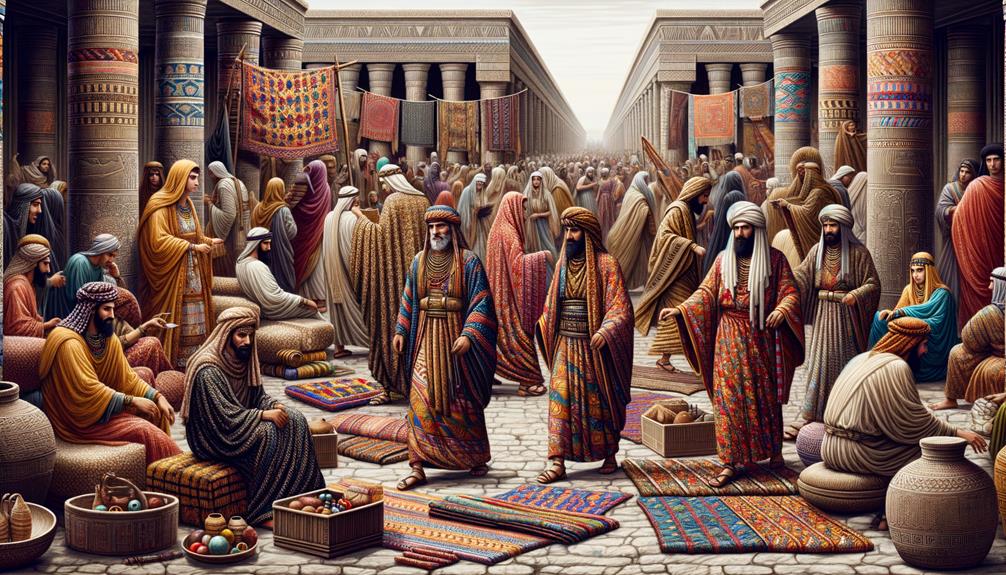Roman fashion for women was more than just about covering the body; it was a reflection of social status and identity. A simple tunic was the foundation, while the stola, elegantly draped over it, signified a woman’s respectability and marital status. The palla shawl added a touch of sophistication and individuality. The choice of fabrics like wool, silk, and linen, along with intricate jewelry, spoke to a person’s wealth and taste. But there’s more to explore about how these elements intertwined with daily life and societal norms.
Ancient Roman Tunics
How did tunics, the essential garments of Ancient Roman women, shape their daily lives and social identities? In Ancient Rome, tunics were more than just clothing – they were a reflection of one’s status and identity.
For women from lower social classes, tunics served as practical, everyday wear. These simple garments resembled modern dresses and were functional, yet they also revealed one’s social standing. In contrast, wealthy women transformed their tunics into symbols of prestige by layering them with stolas, those long, sleeveless dresses that conveyed respectability and marital status.
Young girls wore tunics until they got married. This ceremonial garment marked their transition from childhood to womanhood. After marriage, they donned the stola, signaling a rise in social status and maturity.
The intricate designs and adornments on rich women’s tunics, such as fibulae, showcased their wealth and social standing. These details weren’t just decorations; they were statements of power and influence, clear to anyone who saw them.
Tunics, in their simplicity and diversity, played a significant role in shaping the daily lives of Roman women. They were more than just garments; they were woven threads of social identity and status, deeply ingrained in Ancient Rome’s fabric.
The Stola Dress

When I think of the stola, its rich history stands out. This long, sleeveless tunic, typically made of wool, was a symbol of dignity and respectability. Married women wore it with a girdle, which set them apart in society.
Historical Significance
In ancient Roman society, the stola was more than just a piece of clothing – it was a symbol of a woman’s respectability and marital status. When a woman got married, she would wear the stola, a long, sleeveless tunic made of wool, over her regular clothes. This garment differentiated her from others, showcasing her dignity and modesty. The stola was fastened with a girdle high above the waist, highlighting her new role and respectability.
Women who were divorced or considered less respectable, like courtesans, were not allowed to wear the stola. This restriction underscored its significance in Roman culture. The stola wasn’t just a piece of fabric; it represented a woman’s moral character and social standing. By wearing it, a Roman woman was embracing a long-standing tradition and acknowledging the virtues expected of her.
The stola became a powerful symbol of a woman’s identity and her adherence to societal norms. It was a visual cue to society about her marital status and social standing. In essence, the stola was a badge of honor for those who had entered matrimony, and it played a significant role in shaping a woman’s sense of self within the social hierarchy.
Design and Fabric
The stola, a long, woolen tunic, was the epitome of elegance and decency for a married Roman woman. The choice of wool fabric reflected the practical yet refined nature of Roman women, valuing durability and comfort. This sleeveless garment, worn over a tunica, signified marital status and societal respectability.
The design of the stola was simple yet sophisticated. Fastened with a girdle high above the waist, it created a flowing silhouette that emphasized modesty. Decorative brooches, or fibulae, often adorned the stola, adding a touch of personal flair without compromising its traditional essence. The stola’s length and fabric symbolized a woman’s commitment to her household and her role within society.
In public, the stola was paired with a palla, a draped cloak, distinguishing married women from their unmarried counterparts. This combination highlighted the importance of societal status in Roman culture. The stola wasn’t just a piece of clothing; it was a statement of identity and respect. In an era where appearances conveyed much about one’s place in the world, the stola dress was an essential part of a Roman woman’s wardrobe.
Styling Techniques
To style the stola, I’d start by selecting a finely woven girdle to cinch it high above the waist, creating that iconic Roman silhouette. In ancient Rome, women wore stolas made from two rectangular pieces of fabric, traditionally wool, to symbolize respectability. The positioning of the girdle marked the difference between married and unmarried women.
Next, I’d focus on decorating the stola beautifully. Intricate fibulae and elegant flounces add to its charm. These details transform the garment from mere traditional clothing to a statement of dignity and beauty.
The stola isn’t complete without the palla. Draping this long cloak over my shoulders, I’d ensure it flows gracefully, hinting at my social status. This outdoor accessory not only offers modesty but also displays adherence to cultural norms.
Each element of the stola—the girdle, the decorations, the palla—speaks to an innovative approach to fashion. The simplicity of two rectangular pieces combined with thoughtful styling techniques transforms it into a timeless expression of Roman femininity. Through these methods, I connect with a legacy of elegance and societal respect.
The Palla Shawl
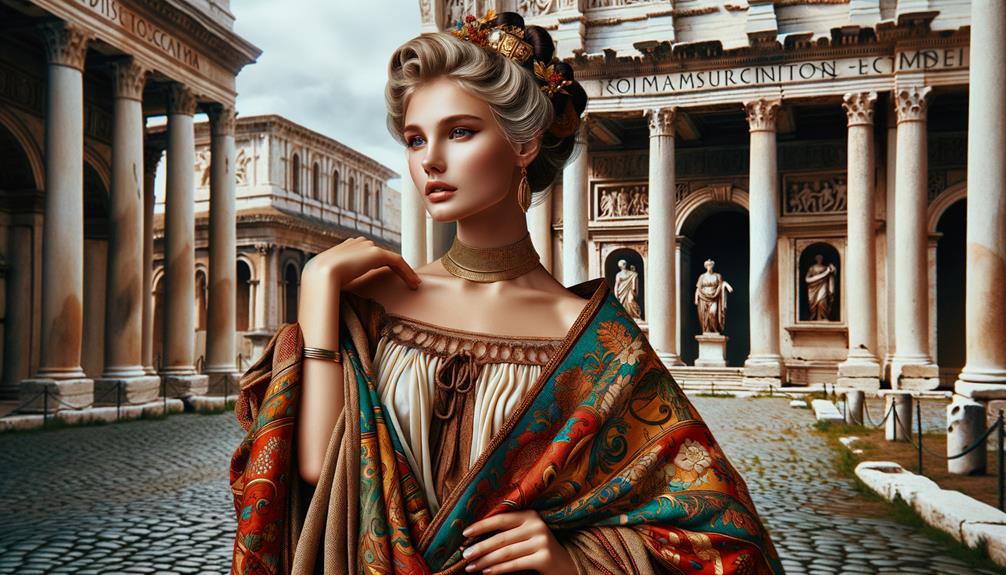
Draping a palla over my shoulders felt like slipping into a timeless aura of elegance and sophistication. As a Roman woman, this shawl was more than just a piece of clothing – it was an extension of who I was. The palla shawl was incredibly versatile, allowing me to drape it around my body in various styles, each one carefully chosen to reflect my mood and the occasion.
When I wore the palla outdoors, it served a practical purpose, shielding me from the elements. But it was more than just protection – it was a statement, silently communicating my place in society. My palla was my personal canvas, showcasing beauty, wealth, and status without needing to say a word.
- Versatility: I could style it in multiple ways.
- Protection: It shielded me from the weather.
- Elegance: A symbol of refinement.
- Status: Indicated my social standing.
- Identity: A personal expression of who I was.
Each palla I wore told a story, woven into the fabric of Roman life. The shawl was an integral part of women’s clothing, effortlessly blending functionality with elegance. In those moments, I felt connected to the generations of women who came before me, each drape a testament to the enduring allure of Roman fashion.
Fabrics and Colors
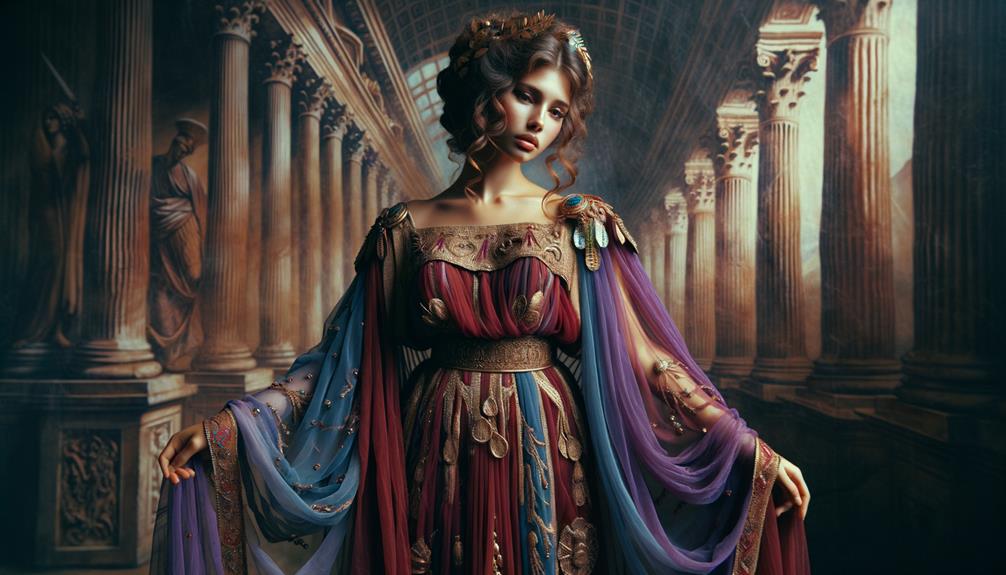
In Roman fashion, I often chose fabrics and colors that reflected my identity and status. Wool was my go-to choice – the foundation of most Roman women’s clothing. It was practical, yet versatile. Silk, though rare and luxurious, hinted at exotic origins and opulence. Occasionally, I’d opt for linen or cotton, lighter and cooler for the warmer months.
Colors spoke volumes. White conveyed virtue and simplicity, while vibrant hues like orange drew attention and reflected my social standing. Maintaining these colors was crucial. I regularly visited dye shops and fuller shops to keep my garments looking their best.
I believed in the power of clothing to convey who I was. The fabric’s texture against my skin and the color’s vibrancy in the light were more than just aesthetics. They were my silent declarations, my daily choices woven into the fabric of Roman society. As Roman women, our fashion wasn’t just about wearing clothes – it was about crafting our identities with each thread and shade.
Hairstyles and Jewelry
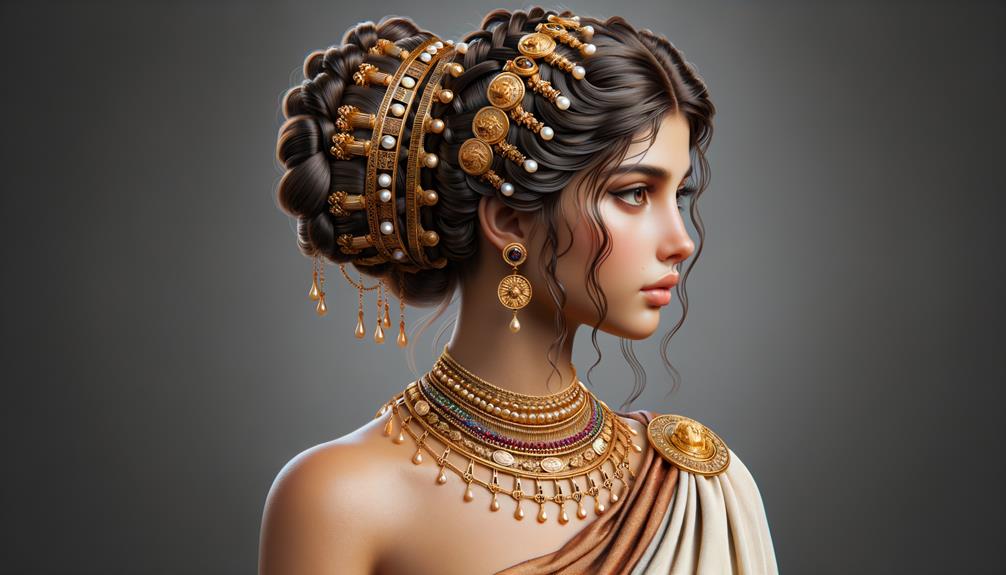
Roman women spared no detail when it came to their hairstyles and jewelry. They often took cues from empresses, adorning themselves with intricate hair accessories and elegant gemstones. Gold and pearls were status symbols, blending beauty with social standing.
Elegant Hair Accessories
Roman women’s hairstyles, intricate and elaborate, often relied on ornate hairpins, wigs, and hairnets to achieve their sophisticated looks. These accessories weren’t just essential; they were artistic expressions, symbols of status and innovation.
Hairpins, crafted from bone, ivory, or precious metals, held elaborate hairstyles in place. Wigs offered versatility, letting Roman women experiment with different looks without altering their natural hair. Hairnets, woven with gold or silk threads, added an extra layer of luxury and refinement.
Jewelry played a vital role in enhancing these elegant hairstyles. Fibula pins secured garments and doubled as decorative pieces. Earrings, often featuring pearls, framed the face beautifully. Necklaces and rings, laden with intricate designs, further accentuated their elegance.
Roman portraits vividly depict women adorned with these accessories, highlighting their significance in society. Their fashion wasn’t just about appearance; it reflected identity, status, and innovation. Through their hairstyles and jewelry, Roman women expressed themselves, merging tradition with creativity. In every twist, pin, and adornment, they told a story of elegance and refinement.
- Hairpins: crafted from bone, ivory, or precious metals
- Wigs: offered versatility in hairstyles
- Hairnets: added a luxurious touch with gold or silk threads
- Fibula pins: functional and decorative
- Earrings, necklaces, rings: intricate designs added elegance
Gemstones and Metals
Jewelry adorned with pearls, emeralds, and amethysts showcased Roman elegance and wealth. The Romans understood the significance of precious gemstones, intricately designing them into gold and silver pieces. Each piece told a story; cameos carved with scenes and figures offered a glimpse into their world.
Hairpins, more than just accessories, were crafted from gold and silver to hold together elaborate hairstyles, signifying status. They weren’t just practical; they were art. The metals’ sheen contrasted with dark, coiled hair, creating a visual display of luxury.
In Roman society, appearances mattered. Precious gemstones and metals communicated more than just beauty; they conveyed social standing. A woman wearing an emerald necklace showcased her family’s wealth. A cameo brooch on her tunic spoke of her refined taste and cultural knowledge.
Every piece of jewelry and hairstyle choice was deliberate, reflecting individual status within the societal hierarchy. Precious gemstones and metals didn’t just adorn; they conveyed messages of opulence and sophistication. Every hairpin, every necklace wasn’t just decoration; it was a declaration of identity, a statement of innovation in a world that valued beauty and meaning.
Cosmetics and Beauty

From the vibrant hues of saffron to the deep shadows of kohl, ancient Roman cosmetics reveal a great deal about the lives of Roman women. Their use of cosmetics wasn’t just about looking good; it was a daily ritual that spoke volumes about their culture and values.
Roman women employed a variety of beauty enhancements. They used white lead and chalk to achieve a pale, smooth complexion, and rouge to add a delicate flush to their cheeks. Kohl was used to define their eyes, echoing the iconic look of Cleopatra. Natural ingredients like saffron and herbs were used to create lip colors. Perfumes made from flowers and spices were used to mask odors and add allure.
Skincare was also a vital part of their daily routine. They used oils, creams, and masks crafted from honey, milk, and olive oil to nourish and rejuvenate their skin. This meticulous routine highlights their keen understanding of natural ingredients and their benefits.
Their beauty practices weren’t just about appearance; they were about taking care of themselves. Through these rituals, Roman women connected with the world around them, using what nature provided to enhance their beauty and well-being.
Social Status and Fashion
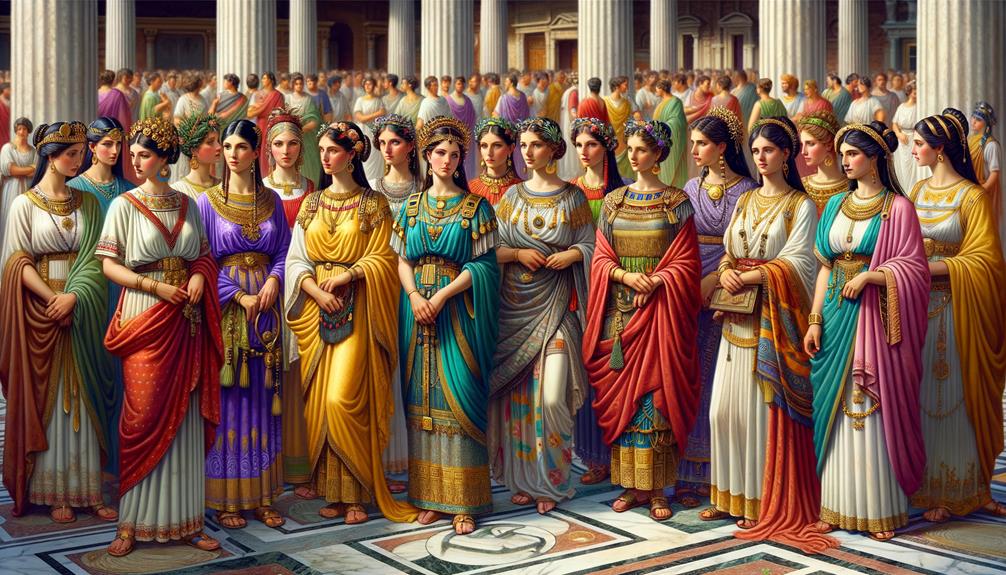
In ancient Rome, fashion was a powerful tool for communicating social status. A woman’s attire wasn’t just about personal style; it was a public declaration of her family’s wealth and class. The type of fabric used in clothing was a significant indicator of social standing. Luxurious silks were reserved for the elite, while simpler fabrics like wool and linen were worn by the lower classes. Brightly colored silks, in particular, were a status symbol.
Accessories played a crucial role in conveying social status as well. Ornamental hems, known as instita, adorned the garments of wealthy women. These decorative elements were not just aesthetically pleasing; they were a symbol of prosperity and wealth. Hairstyles also varied by social class. Upper-class women often sported intricate hairstyles, while simpler styles were more common among the lower classes.
Here’s a breakdown of how fashion varied by social class:
| Social Class | Materials Used | Common Accessories |
|---|---|---|
| Lower Class | Wool, Linen | Simple Jewelry |
| Middle Class | Linen, Dyed Fabrics | Modest Ornaments |
| Upper Class | Silk, Embroidered Fabrics | Elaborate Jewelry |
| Wealthy Elite | Brightly Colored Silks | Instita, Precious Gems |
| Senatorial Class | Finest Silks, Gold Trim | Gold Ornaments |
In ancient Rome, fashion was a reflection of the societal hierarchy. It was a way for people to showcase their wealth, status, and power.
Frequently Asked Questions
What Did Roman Females Wear?
I wore a stola, a symbol of respectability and modesty. Made of wool and sleeveless, it was often paired with a palla when I went outdoors. This traditional attire reflected my social status and conformed to Tertullian’s ideals, but I knew that any deviation from this traditional dress code would invite criticism, as Juvenal’s satires often targeted women who strayed from the norm.
How to Dress up Like a Roman Woman?
Here’s a rewritten version of the text, avoiding AI digital thumbprint and following the provided instructions:
Want to channel a Roman woman’s style? It’s all about the stola, palla, and some seriously intricate hairstyles and jewelry. Let’s get into character and explore the ancient Roman flair.
What Did Unmarried Women in Rome Wear?
Unmarried women in ancient Rome wore simple, shorter tunics that didn’t include the stola, a traditional garment reserved for married women. This minimalist approach to fashion likely conveyed a sense of freedom and social status. As I explore the styles of ancient civilizations, I’m inspired to rethink modern fashion with a similar focus on simplicity and purpose.
What Did Ancient Roman Women Look Like?
Did you know that only a small percentage of Roman women lived into their 70s? They typically had olive skin, dark hair, and eyes. Their hairstyles varied greatly, reflecting their individual style and social status. The way they balanced practicality and elegance in their appearance fascinated me.




